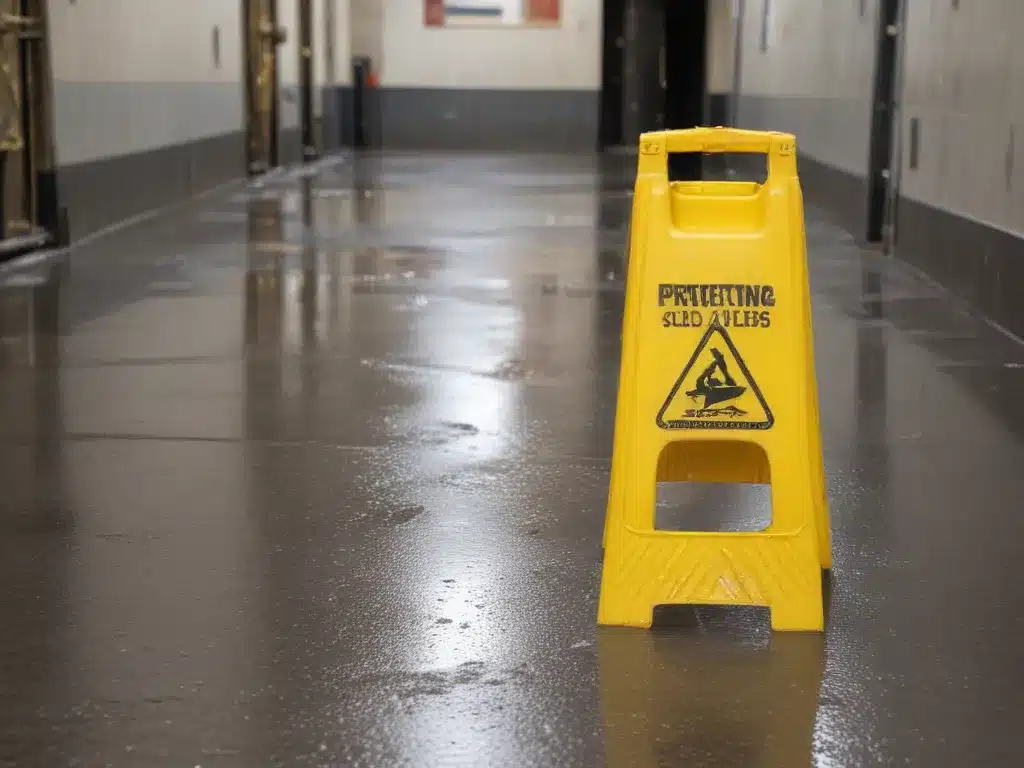Introduction
Slips and falls on wet surfaces are a common occurrence in various settings, including workplaces, public areas, and homes. These accidents can lead to serious injuries, such as broken bones, head trauma, and even permanent disabilities. As a professional cleaning company, we understand the importance of maintaining a safe environment for our clients and their employees or visitors. In this comprehensive article, I will delve into the causes of slips on wet surfaces, discuss effective prevention strategies, and provide practical tips to help minimize the risk of accidents.
Causes of Slips on Wet Surfaces
Lack of Traction
The primary cause of slips on wet surfaces is the lack of traction between the floor and the footwear. When a surface is wet, the friction coefficient (the measure of the force required to move one surface over another) decreases significantly, making it easier for individuals to lose their balance and slip. This lack of traction can be exacerbated by the type of flooring material, the amount of water present, and the condition of the footwear.
Spills and Leaks
Spills and leaks are common occurrences in many environments, ranging from spilled drinks in a restaurant to leaking pipes in a commercial building. If not addressed promptly, these wet areas can become hazardous slip hazards, especially in high-traffic areas or areas with poor lighting.
Poor Drainage
Inadequate drainage systems or clogged drains can lead to the accumulation of water on surfaces, increasing the risk of slips and falls. This issue is particularly prevalent in areas like bathrooms, kitchens, and outdoor spaces where water is commonly used or encountered.
Contaminants
Certain contaminants, such as grease, oil, or soap residue, can make surfaces slippery even when they appear dry. These substances can reduce the friction between the floor and footwear, leading to unexpected slips and falls.
Prevention Strategies
Proper Flooring Selection
Choosing the right flooring material is crucial in preventing slips on wet surfaces. Textured or slip-resistant flooring, such as those made from specialized materials or with added grit or grooves, can provide better traction and reduce the likelihood of slips. Additionally, regular maintenance and cleaning of floors can help maintain their slip-resistant properties.
Effective Drainage Systems
Implementing and maintaining proper drainage systems is essential to prevent water accumulation on surfaces. This includes ensuring that floor drains are clear and functioning correctly, as well as installing sloped floors or channels to direct water away from high-traffic areas.
Prompt Spill Response
Establishing and following protocols for promptly addressing spills and leaks can significantly reduce the risk of slips and falls. This involves training staff on proper spill response procedures, providing readily available spill kits or absorbent materials, and ensuring that wet areas are clearly marked and cordoned off until the issue is resolved.
Proper Footwear
Encouraging or mandating the use of appropriate footwear with good traction can greatly reduce the risk of slips on wet surfaces. Non-slip footwear, designed with specialized soles and treads, can provide better grip and stability, even on wet or slippery surfaces.
Warning Signs and Visibility
Proper signage and visibility measures can alert individuals to potential slip hazards and encourage caution in wet areas. This includes using clear and visible warning signs, as well as ensuring adequate lighting in areas prone to wetness or spills.
Regular Inspections and Maintenance
Conducting regular inspections and maintaining facilities is crucial in identifying and addressing potential slip hazards. This includes checking for leaks, ensuring proper drainage, and addressing any areas where water accumulation or contaminants may be present.
Practical Tips
Wiping Up Spills Immediately
If a spill or leak occurs, it is essential to address it immediately. Use absorbent materials, such as paper towels or specialized spill kits, to soak up the liquid and prevent it from spreading further. Once the area is dry, consider applying a slip-resistant treatment or coating to enhance traction.
Using Proper Cleaning Products and Techniques
When cleaning floors, it is important to use the appropriate cleaning products and techniques that promote slip resistance. Avoid using excessive amounts of water or leaving floors excessively wet, as this can increase the risk of slips. Consider using specialized cleaning solutions designed to enhance traction on wet surfaces.
Implementing Matting Systems
Utilizing matting systems, particularly in high-traffic areas or entrances, can help reduce the amount of water and debris tracked onto floors. These mats should be designed to scrape off excess moisture and contaminants from footwear, reducing the likelihood of slips.
Encouraging Caution and Awareness
Educating employees, visitors, or residents about the risks associated with wet surfaces and encouraging them to exercise caution and awareness can go a long way in preventing accidents. Encourage individuals to report any wet areas or potential slip hazards promptly and to take extra care when walking in areas that may be wet.
Regular Staff Training
Provide regular training to staff members on proper spill response protocols, safe cleaning techniques, and the importance of maintaining a safe environment. Encourage open communication and reporting of any potential slip hazards or areas of concern.
Conclusion
Preventing slips on wet surfaces requires a multi-faceted approach that involves proper flooring selection, effective drainage systems, prompt spill response, appropriate footwear, warning signs and visibility measures, and regular inspections and maintenance. By implementing these strategies and following practical tips, businesses and organizations can significantly reduce the risk of slip and fall accidents, ensuring a safer environment for employees, customers, and visitors. Remember, a proactive approach to slip prevention not only protects individuals from potential injuries but also helps minimize the financial and legal consequences associated with accidents. At Adam Cleaning, we specialize in professional biohazard cleaning services, including the safe and effective cleanup of bodily fluids and other hazardous materials. Visit https://adamcleaning.uk/biohazard-cleaning/ to learn more about our services and how we can help maintain a safe and hygienic environment for your business or property.







